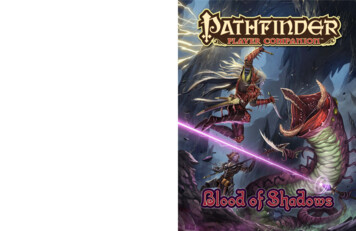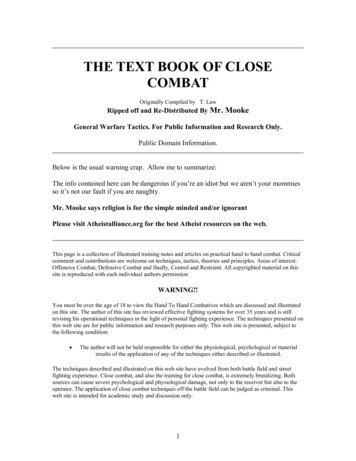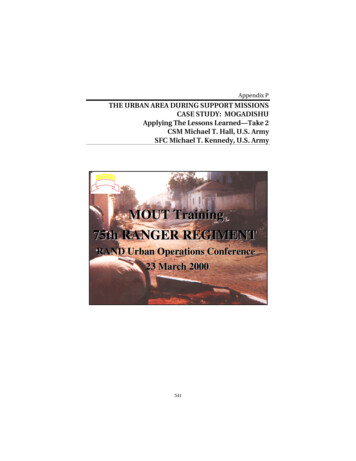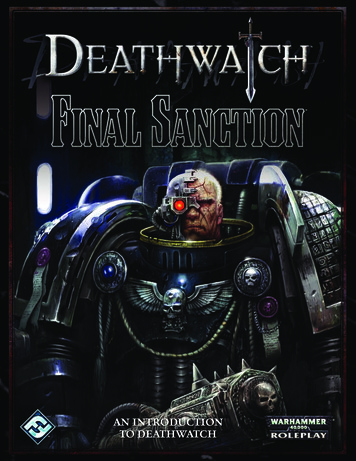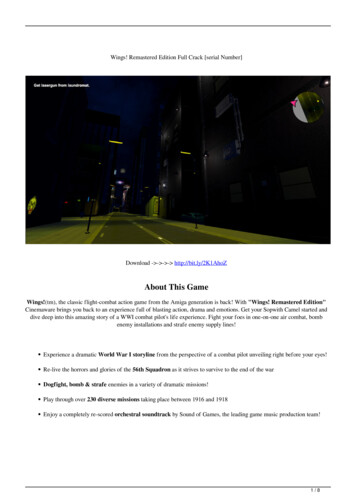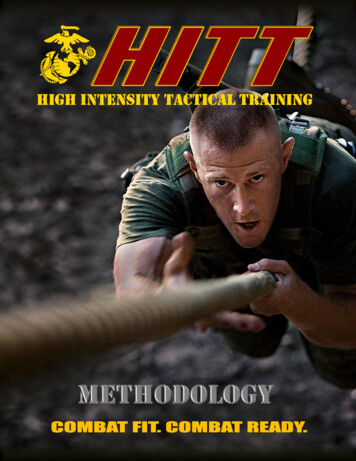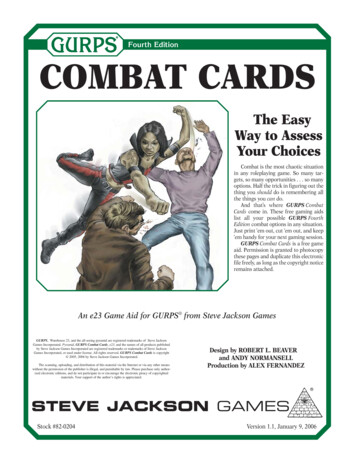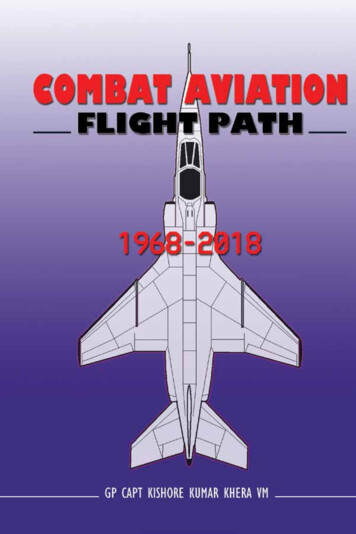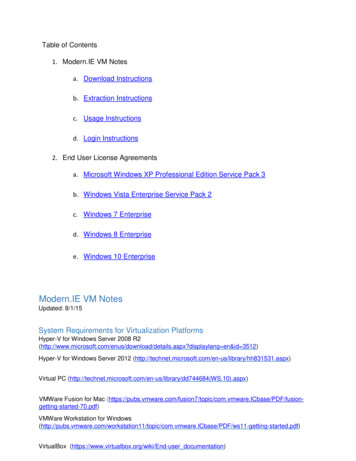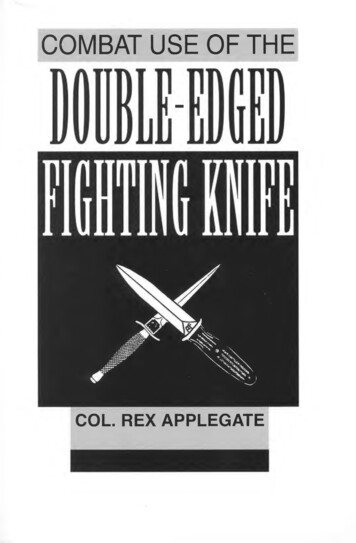
Transcription
COMBAT USE OF THECOL. REX APPLEGATE
Also by Rex Applegate:Bullseyes Don’t Shoot Back (with Michael D. Janich)Close-Combat Files of Colonel Rex Applegate (with Maj. Chuck Melson)Kill or Get KilledPoint Shooting (video)Scouting and PatrollingShooting for Keeps (video)CONTENTSIntroduction.1Combat Use of the Double-Edged Fighting Knifeby Col. Rex ApplegateScope and Orientation.3The Knife Blade and Handle.5Copyright 1993 by Col. Rex ApplegateCorrect Grip.ISBN 10: 0-87364-735-1ISBN 13: 978- 0-87364-735-9Printed in the United States of America7Stance.11Knife Manipulations.13Published by Paladin Press, a division ofPaladin Enterprises, Inc.Gunbarrel Tech Center7077 Winchester CircleBoulder, Colorado 80301 USA 1.303.443.7250Tactics.15Direct inquiries and/or orders to the above address.Practice.25PALADIN, PALADIN PRESS, and the “horse head” designare trademarks belonging to Paladin Enterprises andregistered in United States Patent and Trademark Office.Knife Defense.27All rights reserved. Except for use in a review, noportion of this book may be reproduced in any formwithout the express written permission of the publisher.Vulnerable Points.17Utility Knives—Knife Throwing .21Knife Maintenance.23Sheath.29History of the Applegate-Fairbairn Knife.33Sources for Knives, Books, and Videos.37Neither the author nor the publisher assumesany responsibility for the use or misuse ofinformation contained in this book.Visit our Web site at www.paladin-press.comV
WARNINGThis book isfor information and historicalpurposes only. It is nota training manual. The techniques and drills depicted in this bookare extremely dangerous. Do not attempt any of these techniquesand drills without proper professional supervision and training.Attempting to do so can result in severe injury or death.The author and the publisher expressly disclaim any liabilityfrom any damage or injuries that a user of this book may suffer.The author and the publisher expressly disclaim any liability fromany damage or injuries to third parties from the user of this book.INTRODUCTIONTraining in knife fighting as a specific skill was first introducedduring World War II. It was first taught to the BritishCommandos and other Allied special forces. Later, Office ofStrategic Services (OSS) personnel, U.S. Army Rangers, U.S.Marine Corps Raiders, airborne troops, and other elite Americanunits received such instruction. The knife-fighting techniquesadvocated were generally based on the methods described in thebooks Get Tough (W.E. Fairbairn, 1942) and Kill or Get Killed(Rex Applegate, 1943), covering the combat use of the FairbairnSykes Commando knife.After training and close association with both W.E. Fairbairnand E.A. Sykes while assigned to the OSS in 1943, this writer wasordered to duty at the U.S. Army Military Intelligence TrainingCenter at Camp Ritchie, Maryland. The purpose of the assign ment was to organize and direct the Combat Section of this newcenter, where intensive close-quarter armed and unarmed combatinstruction was the training mission. Over the ensuing two years,approximately ten thousand trainees from all walks of life andwith many foreign language capabilities were processed there.During this time my instructional staff and I were exposed totrainees who, because of their various ethnic backgrounds, had agreat deal of experience in use of the knife as a primary fightinginstrument. We evaluated practically all of the worlds knife-fight ing techniques with single- and double-edged blades; however,VI1
COMBAT USE OF THE DOUBLE-EDGED FIGHTING KNIFESCOPE ANDORIENTATIONThe purpose of this manual is to teach proper use, in closequarter combat, of a knife specifically designed for that purpose.Col. Rex Applegate is universally recognized as one of the foremost authoritieson close-combat with or without weapons. His three books are used worldwideby military and police. Kill or Get Killed is the best-selling book on close-combatBasic information is presented to instill confidence and provideskill in the use of the double-edged knife.A properly trained knife fighter armed with a double-edgedin history. Riot Control and Scouting and Patrolling are acclaimed as the basicknife should prevail in any close-quarter encounters against individ texts on the subjects.uals armed with most weapons, other than firearms. In fact, at closequarters, given the element of surprise, the opponent armed with anothing evolved superior to the basic Fairbairn-Sykes techniquehandgun is still vulnerable to deadly attacks against a trained knifewith the double-edged knife.fighter. “One-on-one” knife-fighting incidents—where both menCurrently, there are a number of commercially available dou are forewarned, similarly armed, and engaged—are extremely rare.ble-edged knives that the modern student of knife fighting canGenerally, knife confrontations should be over in seconds when theemploy in the manner to be discussed. Their effectivenesstrained knife fighter is pitted against an untrained, or unprepared,depends on blade design, balance, handle shape, etc., as well asopponent—especially when the element of surprise is present.the skill of the user. The Randall #2, the Gerber Mark I and II(with variations), the Kershaw Trooper, the A1 Mar Shadow, theApplegate-Fairbairn (A-F) models, some EK models, and simi lar types fall in this category. U.S. Army Trench Knife M3 andbayonets M4, 5, 6, and 7 can all be used to a lesser degree in thesystem to follow.This writer favors the current custom and commercial models ofthe A-F for stated, practical, and combat-proven reasons.23
THE KNIFE BLADEAND HANDLEThe heart of the fighting knife is its blade. It should be 5 to 7inches in length, double-edged, and wide enough to be razor sharpon both sides all the way back to the cross guard. The point must besharp enough to penetrate and thick and tough enough to with stand side pressure.The blade should provide slashing, ripping, and thrustingcapabilities. Stainless type steel, correctly tempered, with a dullfinish is preferable. The blade should be tempered to hold an edgeas well as being easily sharpened and, at the same time, not brittle.The oval-shape handle should fit the palm of the hand and bedesigned so that the edges of the blade can be immediately, andautomatically, located in dark or light conditions. A nonslip sur face is another feature that should be incorporated. The handleshould not turn in the hand (sweaty palms, etc.) when the bladestrikes resistance. The knife should be handle heavy with relationto balance. Nothing in the design should limit its possibilities foruse as a weapon from any position or either hand. The overalllength should be approximately 10 to 11 inches; anything longermakes it too unwieldy and cumbersome to carry. The weightshould be in the 1/2 to 3/4 pound range.5
CORRECT GRIPA.The handle of the knife lies diagonally across the palm ofthe holding hand. The blade extends from the thumb side, the han dle end from the little finger side.B.The thumb and index finger tightly grasp the handle inthe area nearest the cross guard. The tip of the thumb is wedgedagainst the guard, as is the first point of the index finger, which iscurled around the handle beneath the thumb.C.The remaining fingers lie over the handle in a naturalfashion; the second finger lies over the largest diameter of the ovalhandle. The ring finger lies behind the second finger, and the littlefinger lies over the handle’s smallest diameter, near the pommel.D.The weapon’s point of balance is back from the guard,under the index finger. The knife is controlled by the thumb andindex finger and by turning the wrist (palm up or down), depend ing on the slashing stroke to be used. Like tennis, the palm isdown for a backhand stroke, or slash, and up for a forehand. Thistype of grip is essential to proper employment of the knife incombat. At the time of contact with the opponent, all fingers gripthe handle tightly. Used with this fencing foil-type grip, the knifebecomes an extension of the hand, not an appendage.7
COMBAT USE OF THE DOUBLE-EDGED FIGHTING KNIFECOL. REX APPLEGATEThe correct fenc TOP: The ice pick-ing-foil, across-the-type grippalm-type gripwhen one is using aCENTER: The ham double-edgedmer type.fighting knife.Grasped in thisBOTTOM: Razormanner, the knifegrip with singlebecomes an exten edge protrudingsion of the hand.from little fingerBy turning theside of hand, withwrist, thrusts, fore blade parallel tohand and back forearm.hand slashes, andripping strokes arepossible. This gripworks with eitherhand.VARIOUS KNIFE GRIPSThe ice-pick grip is often used when the knife isside of the palm, edge forward. The blade is held parallel to thegrasped by an unskilled person. The handle is grasped tightly inA.arm, etc. Offensive movement is confined to horizontal slashes,the fist, with the blade extending downward from the little fin and a return thrust may be executed. The entire basic stroke can beger side of the hand. The basic offensive movement is limited toblocked.a downward stabbing motion or upward slash, for which thereare several effective defenses.semiskilled) persons, generally using a single-edged knife. TheirB.All the above grips are commonly used by unskilled (or a fewThe hammer grip is characterized by gripping the han basic weakness is that they require the knife wielder to getdle in the manner of a hammer handle, with the blade extendingextremely close to the opponent, where various blocks, parries, dis upward from the thumb side of the hand. Offensive movementarming methods, and offensive countermeasures can be employedis confined to an upward thrust or downward slash, which is rel atively simple to block or parry.against the user.C.The razor grip, popularized in the movies, is typicallyemployed as a surprise slashing attack by a semiskilled person. Itis a popular one for use with a single-edge knife or razor. Thehandle is turned down, and the blade protrudes from the finger89
STANCEA correct stance, using the double-edged blade, allows forrapid movement, maneuverability, and attack while keeping theopponent at a distance.A. Holding the head erect, drop into a balanced crouch withthe knees flexed, feet about shoulder-width apart, and one footadvanced in front of the other. Your center of gravity should be inthe stomach-abdomen area, which is the most vulnerable area toprotect from your opponent’s blade.B. Using the correct grip, hold the knife hand close to yourbody at waist level.C. The free hand should be extended slightly in front, at alevel between the waist and knee, while in a crouch. Shouldersshould be lowered, in a relaxed position, and with the free-handshoulder slightly ahead of the other.D.The correct stance keeps your knife hand well out of youropponents reach and allows the free hand to make feints or parries,misdirect the opponents eyes, or throw objects to disconcert theenemy. This protects the vulnerable midsection and puts you in aposition to move to meet any type of attack or counter any defense.11
COMBAT USE OF THE DOUBLE-EDGED FIGHTING KNIFEThe knife fighterKNIFEMANIPULATIONSviewed from thefront. The freehand can be usedto throw objectsinto adversaries’eyes, make dis tracting move ments, and fendoff, or parry, defen sive action orattacks with aweapon used byA.the opponent.By using the correct stance, you are able to direct slashesto the adversary’s face, neck, hands, and legs with a double-edged,razor-sharp knife. Disabling slashes to the tendons of the inside ofthe wrists and back of the hands are very effective.B.Using the correct stance and grip, effective thrusts can bemade to the throat, trunk, stomach, groin, or heart. Deep cuts,slashes, and thrusts to the heart area and throat usually are immedi The correct way toately fatal. When practicing,, get into the habit ofexecuting a ‘ripping’motion as you withdrawfrom a thrust to a vital area.carry the knife froman aggressive for C.ward crouch. TheThe best thrusting method is to move forward and pivotfeet should beon your forward leg, while simultaneously snapping your bladeplaced one in frontforward at the same time your opposite leg, shoulder, and armof the other in amove backward, etc.position wherebybalance is alwaysmaintained and thebody position canbe changed in anydirection by footmovement.1213
COMBAT USE OF THE DOUBLE-EDGED FIGHTING KNIFEA slash to the backof the hand willTACTICSsever tendons sothat control of thefingers will be lost.A.Always use surprise, if possible, in your attack.B.Many times a scream, yell, or battle cry accompanied by asurprise attack will so destroy your enemy’s mental balance that hewill be disabled, or dead, before he has a chance to react.C.Use your free hand to create movement, diverting theenemy’s eyes from your knife hand. Use feints; throw handfuls ofdirt, gravel, coins, etc., into his face; or try some similar ruse.D.Coupled with feints involving the free hand, constantlymake continuous false moves with your knife hand from thethroat to knee area and then follow up with a slash to the arm,wrist, face, and throat. For example, a slash across the foreheadwill instantly cause a flow of blood to blind your opponent, etc.E. Generally disabling slashes to the wrist, biceps, etc., are realbuilding blocks to finishing off with a well-placed thrust.1415
VULNERABLEPOINTSStudies conducted by law enforcement agencies show thatapproximately 50 percent of all fatal knife attacks involve multiplethrusts to the trunk area, while almost 40 percent involve the headand neck area. Generally speaking, thrusts are more effective thanslashes in causing death. Slashes, however, are the real “steppingstones” of knife fighting. Slashes and cuts to the hands, wrists, andforearms disable and demoralize your enemy to the point that youcan finish him off with a well-placed thrust to vital areas.ARTERIESA.Study the accompanying diagram carefully. The approxi mate positions of vulnerable arteries are given. A strike to any oneof them will cause unconsciousness within two to 30 seconds anddeath in a maximum of two minutes. Remember the position ofeach; do not worry if you cannot remember the names.B.Following is a list of vulnerable points where knifewounds will be particularly effective.HEAD AND NECK AREASA.Base of skull (thrust)B.Temple (thrust)C.Eyes and forehead (thrust or slash)17
COMBAT USE OF THE DOUBLE-EDGED FIGHTING KNIFECOL. REX APPLEGATED.Mouth (thrust or slash)E.Side of neck (slash)F.Beneath chin (thrust or slash)G.Base of throat (thrust)TRUNKA.Heart (thrust)B.Stomach (thrust, slash, rip)C.Kidney (thrust, rip)D.Groin, abdomen, stomach (thrust, slash, rip)LIMBSA.Biceps (slash)B.Forearm (slash)C.Wrist (inside slash)D.Back of hand, fingers (slash)E.Thigh (inside slash)This diagram from W.E. Fairbairn’s Get Tough shows vulnerable arteries, varyingin size from a thumb to a pencil in diameter. Thrusts to the heart and slashes tothe throat are the most deadly strokes. The psychological and shock effect of athrust or slash to the stomach-groin area is very effective and usually will causethe recipient to lose his mental balance and control, even though it is not imme diately fatal.1819
UTILITY KNIVES—KNIFE THROWINGAlthough, single-edged utility knives can be used for combat,they are less suitable. They are designed to be of more service indressing game or performing routine camp cutting chores, etc.Although you can use any double-edged fighting knife for non combat purposes, it is best to carry an additional utility singleedged knife such as a Kabar.Knife throwing is for the circus or vaudeville stage. To throw aknife so it will strike point-first, you must know the exact distanceto accurately predict the number of revolutions the knife willmake as it revolves through the air. Throwing a knife under condi tions of combat and stress is not advised and will probably onlyresult in loss of the weapon.21
KNIFEMAINTENANCESHARPENINGA.Fighting blades require a keen edge, sharpened on agood-quality natural or synthetic sharpening stone. A doublefaced stone with both medium and fine grits is ideal. In the field,use water or saliva to lubricate your sharpening stone. However,light machine oil is the best stone lubricant.B.Blade edges are maintained at an approximate 15- to 20-degree angle. A greater angle will be too blunt and will dull quickly;a lesser angle will be too thin and is prone to chipping.C. In order to give your blade the required 20-degree edge,proceed as follows:1. Lubricate your stone with water or oil and place one flat of theblade against the surface of the stone.2. Tilt the center of the blade up 1/16 of an inch, as if you wereabout to slice away a thin film from the stones surface.3. Sweep the edge of the blade off the stone from heel to point.Use an even, steady stroke and maintain your angle.4. There are numerous sharpening devices on the market thatenable correct sharpening of angles to be maintained.5. Turn the blade over and repeat the operation. Sharpen byalternating sides equally.6. Finish by stropping the blade on the heel of your hand, yourleather scabbard, or belt.23
COMBAT USE OF THE DOUBLE-EDGED FIGHTING KNIFERUST PREVENTIONPRACTICEAlthough most modern blades are made from so-called“stainless steel,” cleanliness is still your best protection againstrust or corrosion. Never allow blood to dry on your blade, and becertain to wipe and oil the blade after use. Do not store yourblade in a leather scabbard for long periods of time. Certainchemicals used in the tanning process may cause corrosion.Although knife-against-knife encounters are extremely rare,two-man “one-on-one” practice with rubber knives and protectivegoggles is still recommended. Edges of the knives can be coatedwith chalk or old lipstick to leave marks so as to create realism.A cutting tree usedfor training. It is a4-inch pole cov ered with cut-upsections of auto mobile tires; a baleof hay, cotton,rags, or othermaterial is placedin back. Cuts,thrusts, and slash es (always followedup by a rippingmotion on with drawal) should bepracticed until theyare instinctive andautomatic.2425
ICOMBAT USE OF THE DOUBLE-EDGED FIGHTING KNIFEAnother practicing technique is to construct a cutting treeKNIFEDEFENSEfrom old tire casings. This proved to be a useful device in train ing during World War II.Against the type of knife fighting and manipulation describedin this text, conventional knife defenses—as taught in most policeacademies, martial arts schools, and military installations—aregenerally unsatisfactory. Only the most skilled, highly trainedindividuals can successfully prevail in unarmed encounters in oneon-one situations. The best defenses are: run; shoot; or use abaton, club, chair, or other improvised weapon.One of the best police-training videos is Surviving EdgedWeapons from Calibre Press. This video should be shown to allserious knife-fighting trainees. It is significant that no practicalunarmed defense in this training tape is advocated against thetechniques described herein.2627A
SHEATHThe sheath should be made of a quality, thick, or tannedleather that will keep its shape (not warping) after continuousfield use. Leather conditioner should be used when necessary.Sheaths made of plastic or other man-made materials are alsoacceptable. A good fighting knife demands a quality sheath.29
COMBAT USE OF THE DOUBLE-EDGED FIGHTING KNIFECOL. REX APPLEGATEA razor-sharp, dou ble-edged knifecan be dangerousto the user, particu larly when insertingin the sheath off thebelt. Even whenhanging on thebelt, care and timeshould be taken toinsert the bladepoint. Leathersheaths that havebeen exposed tothe elements(becoming wet andthen dry) can losetheir shapes andsometimes warp.Off the belt, do nothold the sheath inthe palm of thehand when insert ing the knife. Hookthe thumb in thebelt loop as illus trated above.Loop one end overand behind handle.It is the practice among paratroopers to tie their knives in a handle-down positionprior to jumping. Due to an accident or a faulty retaining strap or snap, often theknife is lost on impact with the ground. The above method, using the hollow, tubulargrommets in the sheath, provides insurance against knife loss and still permits theknife to be withdrawn by breaking the rubber band (or string) at the time of removal.
HISTORY OF THEAPPLEGATEFAIRBAIRN KNIFEThe A-F fighting knife is a double-edged weapondesigned primarily for combat use. Any utility value it mayhave is secondary. It is the only fighting knife ever designedbased on extensive after-action combat reports that took placeduring World War II, when thousands of men were trainedwith and used the Fairbairn-Sykes (F-S) Knife, designed byE.A. Sykes and W.E. Fairbairn of Shanghai police andBritish commando fame.The original F-S was popularly known as “The CommandoKnife” or dagger. It became the most famous fighting knife designin history, and it was issued by British Ordnance and later by theAmerican OSS. Crossed Commando knives appeared on variousshoulder patches and insignia, becoming symbols of the victoriousAllied war effort over the Axis forces.As World War II progressed, many negative combat reportsbegan to accumulate regarding the original F-S, which was at thattime being manufactured by a number of British firms whose atten tion to quality of blade materials and adherence to the originaldesign (by Wilkinson Sword) were poorly executed.Reports from the battlefront indicated that the knives were notonly being misused by the troops for utility purposes, but were alsotoo weak in the blade, breaking at the tip and at the cross guard.It was almost impossible to sharpen them to get a good cut ting edge because of the narrow width and thickness of the33
COMBAT USE OF THE DOUBLE-EDGED FIGHTING KNIFECOL. REX APPLEGATEThe first patternFairbairn-SykesCommando dag ger manufacturedby WilkinsonSword. Later mod els issued byBritish Ordnancewere of slightly dif ferent blade andhandle configura tion and belowearlier quality stan dards.blade and sharp angle of the grind. The Coke-bottle-shapedhandle permitted slippage.Not only was the round handle too small for many hands, italso did not allow (especially at night) for the user to be able toinstantly locate, by “feel,” the blades edge. Some reports actuallycame back where men had tried to cut the throats of enemy sen tries with the flat of the blade.This writer retained the original prototype knife, along withthe original drawings. Renewed interest in fighting knivesprompted the introduction in 1983 of a relatively inexpensive cus tom-made version of the A-F Knife. This model is still available,and more than a thousand of these custom knives have now beensold to collectors and members of special elite military units.In late 1943, W.E. Fairbairn and this writer redesigned theBALANCEknife to correct the problems being encountered on the battle field. The blade was widened, strengthened, and redesigned tohold an edge, the tang strengthened, and the handle made moreoval. In 1944, a prototype was produced that corrected most ofthe combat faults that had become evident. Unfortunately, bythat time the pace of the war had increased and the prioritieswere such that the prototype was never put into production.Baseball players have favorite bats; golfers prefer certain clubs.Likewise, the balance and “feel” of any double-edged fightingknife is an important psychological element in the selection of amake or model. This important factor is very evident when theA-F Knife is selected over other types. A simple test emphasizesthis point.3435
COMBAT USE OF THE DOUBLE-EDGED FIGHTING KNIFE1.Place a number of various double-edged fighters on atable (Randall, Gerber, Kershaw, A-F, Ek, etc.)2.Blindfold the trainee, who need not have had any previ ous indoctrination or familiarity with such knives.3.H ave the trainee pick up the knives one by one andevaluate them based on balance and feel alone.SOURCES FOR KNIVES,BOOKS, AND VIDEOSChances are overwhelming that he will pick the A-Fbecause of its feel and handle design. The lead weights placed inthe handle contribute to this selection.THE A-F HANDLEThe long, oval-shape, palm-filling handle greatly increas KNIVESes maneuverability when gripped tightly. The “no-slip” factoris critical. Sweaty palms caused by combat tension, blood,Applegate-Fairbairn Knife (commercial models, training knives)etc., combined with a smooth handle surface, are a surerecipe for disaster and knife loss when the blade meets resist Supplier: Boker USA, Inc.ance. The A-F Knife handle is made of molded plastic1550 Balsam Street(Lexan), thereby permitting the addition of the deep, longi Lakewood, CO 80214tudinal grooves and balance-influencing lead weights. A800-835-6433hard, combat-induced hand grip forces the flesh of the palmwww.bokerusa.cominto the grooves, forming a secure bond between the handand knife under combat conditions.BOOKSA commercial model of the A-F Knife is now being offeredto the public at a greatly reduced price with no appreciable sacri Combat Use of the Double-Edged Fighting Knifefice in quality. It is hoped that more of the worlds fighting menGet Toughwill be able to take advantage of the A-F Knife, now proven onthe world s battlefields.Kill or Get KilledSupplier: Paladin Press7077 Winchester CircleBoulder, CO 80301800-392-2400www.paladin-press.com3637
A properly trained knife fighter armed with adouble-edged knife should prevail in any closequarter encounter against an individual armedwith most weapons—except a firearm. And eventhen, given the element of surprise, an opponentarmed with a handgun is still vulnerable toattacks against a trained knife fighter.Col. Rex Applegate, universally recognized asone of the foremost authorities on close combatwith or without weapons, wrote Combat Use ofthe Double-Edged Fighting Knife to instill inreaders the skills and confidence necessary forcontemporary close-quarter knife fighting.Working with W.E. Fairbairn in 1942, ColonelApplegate helped to develop silent-killing instruc tion for America’s first behind-the-lines OSSagents. The two also were responsible for comingup with the Applegate-Fairbairn Fighting Knife,generally regarded as one of the best doubleedged combat blades in the world.Now you, too, can receive the same personal ized close-quarter knife-fighting instruction thathas benefited select U.S. armed forces and federalinvestigative and intelligence personnel.A PALADIN PRESS BOOKwww.paladin-press.comISBN: 978-0-87364-735-9
COMBAT USE OF THE DOUBLE-EDGED FIGHTING KNIFE . Col. Rex Applegate is universally recognized as one of the foremost authorities on close-combat with or without weapons. His three books are used worldwide by military and police. Kill or Get Killed is the best-selling book on
